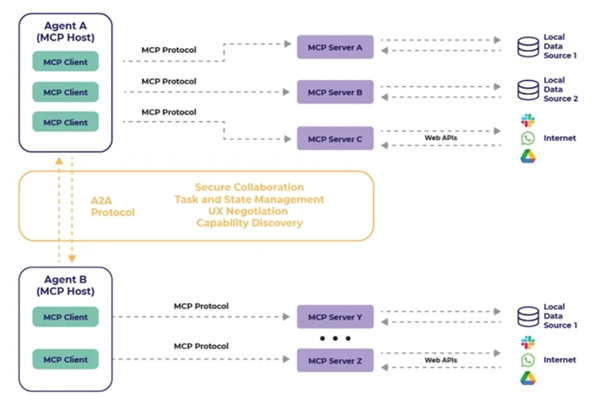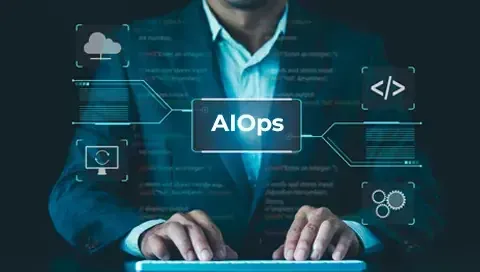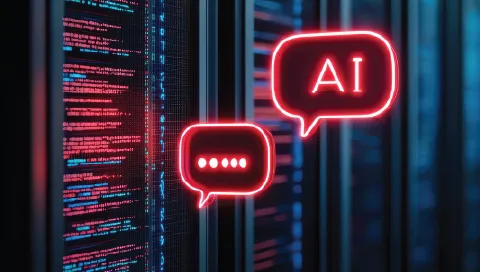This is Part 2 of our series on Building Intelligent AI Systems. In Part 1, we explored Agentic AI fundamentals and design patterns. Now, let’s dive deep into Google’s Agent-to-Agent (A2A) Protocol — the game-changing standard that’s revolutionizing how AI agents communicate and collaborate.
Introducing Google’s A2A Protocol
The Agent-to-Agent (A2A) Protocol addresses a critical challenge in modern AI deployment: enabling seamless communication between agents developed on different platforms, frameworks, and cloud environments.

Visualization of Google’s A2A Protocol enabling communication between Client and Remote Agents
for secure collaboration, task management, and capability discovery.
Key Features of A2A Protocol
- Standardized Communication: Universal messaging format across all AI agents
- Cross-Platform Compatibility: Seamless integration regardless of underlying technology
- Scalable Architecture: Easily add new agents without system disruption
- Real-time Collaboration: Instant communication and task coordination
- Enterprise-Ready: Built-in security and authentication mechanisms
What Makes A2A Essential
A2A protocol serves as a universal communication standard that allows AI agents to:
- Share goals and coordinate tasks across platforms
- Exchange data and context in standardized formats
- Collaborate regardless of underlying technology stack
- Operate in distributed, cloud-agnostic environments
The Interoperability Challenge
Before A2A, organizations faced significant challenges:
- Custom Integration Overhead: Each agent connection required bespoke development
- Inconsistent Communication: Different formats across agent implementations
- Limited Scalability: Tightly coupled systems difficult to extend
- Maintenance Complexity: Multiple integration points to manage
A2A protocol transforms this landscape by providing:
- Standardized Communication: Consistent message formats across all agents
- Plug-and-Play Integration: Easy addition of new agents without system disruption
- Cross-Platform Compatibility: Seamless operation across different frameworks
- Reduced Development Time: Standard implementation patterns
- Framework Agnostic: A2A offers a standard interface regardless of the chosen agentic framework.

Google’s Agent-to-Agent (A2A) Protocol connecting Client Agents with Remote Agent coded using frameworks like Crewai and LangChain for seamless interoperability
Core Components of A2A Protocol
Understanding A2A implementation requires familiarity with its fundamental components:

Google’s Agent-to-Agent (A2A) Protocol showcasing core components such as A2A Client, Server, Task Management, Messaging, and Streaming.
Agent Discovery
- Agent Card: Metadata profile describing capabilities and communication preferences
- Discovery Endpoint: Standardized location for agent information (/.well-known/agent.json)
- Capability Matching: Automated selection of appropriate agents for specific tasks
A2A Client & Server
The A2A protocol operates through two main components:
- A2A Client: Initiates communication with remote agents, handles task submission, and monitors progress
- A2A Server: Receives and processes incoming tasks, manages agent capabilities, and returns results
Task Management
- Task Object: Structured work units with clear objectives and data
- Status Tracking: Real-time progress monitoring (pending, working, completed)
- Artifact Handling: Structured output containing results in multiple formats
Communication Protocols
- Message Exchange: Structured communication between agents
- Push Notifications: Real-time updates on task progress and status changes
- Streaming Support: Continuous data exchange for long-running tasks
A2A Communication Flow Implementation
The A2A protocol defines a four-step communication process ensuring consistency and reliability:

Step-by-step flow of A2A communication from agent discovery to result delivery.

Four-step A2A communication process demonstrating agent discovery, task initiation, status updates, and result delivery for seamless multi-agent coordination.
Code Examples for A2A Implementation
A2A Client Implementation
import requests
import json
from typing import Dict, Any, Optional
class A2AClient:
def __init__(self, base_url: str, auth_token: Optional[str] = None):
self.base_url = base_url
self.auth_token = auth_token
self.headers = {"Content-Type": "application/json"}
if auth_token:
self.headers["Authorization"] = f"Bearer {auth_token}"
## Step 1 : Agent Discovery
async def discover_agent(self) -> Dict[str, Any]:
"""Retrieve agent capabilities and endpoints"""
url = f"{self.base_url}/.well-known/agent.json"
response = requests.get(url, headers=self.headers)
response.raise_for_status()
return response.json()
## Step 2: Task Initiation
async def send_task(self, task_data: Dict[str, Any]) -> Dict[str, Any]:
"""Send task to remote agent"""
agent_info = await self.discover_agent()
task_endpoint = agent_info["endpoints"]["tasks"]
url = f"{self.base_url}{task_endpoint}"
response = requests.post(url, json=task_data, headers=self.headers)
response.raise_for_status()
return response.json()
## Step 3 : Get Status Updates
async def get_task_status(self, task_id: str) -> Dict[str, Any]:
"""Check task progress and status"""
url = f"{self.base_url}/api/tasks/{task_id}/status"
response = requests.get(url, headers=self.headers)
response.raise_for_status()
return response.json()
## Step 4 : Process Request & Get Results
async def process_customer_feedback():
client = A2AClient("https://sentiment-agent.example.com", "your-auth-token")
task_data = {
"task_id": "feedback-analysis-001",
"message": "Analyze customer sentiment",
"parts": [
{
"type": "text",
"content": "Customer feedback data to analyze..."
}
]
}
result = await client.send_task(task_data)
print(f"Task submitted: {result['task_id']}")
# Monitor task progress
while True:
status = await client.get_task_status(result['task_id'])
if status['status'] == 'completed':
print(f"Analysis complete: {status['artifacts']}")
break
elif status['status'] == 'failed':
print(f"Task failed: {status['error']}")
break
A2A Server Implementation
Python (Flask-based) Example:
from flask import Flask, request, jsonify
import uuid
from datetime import datetime
from typing import Dict, Any
app = Flask(__name__)
class A2AServer:
def __init__(self):
self.tasks = {}
self.agent_capabilities = {
"name": "Sentiment Analysis Agent",
"version": "1.0.0",
"capabilities": [
"sentiment-analysis",
"text-classification",
"emotion-detection"
],
"endpoints": {
"tasks": "/api/tasks/send",
"status": "/api/tasks/{task_id}/status"
}
}
def process_task(self, task_data: Dict[str, Any]) -> Dict[str, Any]:
"""Process incoming task and return result"""
task_id = task_data.get('task_id', str(uuid.uuid4()))
# Simulate task processing
self.tasks[task_id] = {
"status": "working",
"created_at": datetime.now().isoformat(),
"progress": 0
}
# Actual processing logic would go here
result = {
"sentiment_scores": {
"positive": 0.75,
"neutral": 0.15,
"negative": 0.10
},
"confidence": 0.92
}
self.tasks[task_id] = {
"status": "completed",
"artifacts": [{"type": "data", "content": result}],
"completed_at": datetime.now().isoformat()
}
return self.tasks[task_id]
server = A2AServer()
def get_agent_card():
"""Return agent capabilities and endpoints"""
return jsonify(server.agent_capabilities)
def send_task():
"""Process incoming task request"""
task_data = request.json
result = server.process_task(task_data)
return jsonify(result)
def get_task_status(task_id):
"""Return task status and progress"""
if task_id not in server.tasks:
return jsonify({"error": "Task not found"}), 404
return jsonify(server.tasks[task_id])
if __name__ == '__main__':
app.run(debug=True, port=5000)
Streaming Task Execution
For long-running processes, A2A supports streaming communication using
tasks/sendSubscribe:
POST /api/tasks/sendSubscribe
{
"task_id": "streaming-task-001",
"message": "Generate comprehensive market analysis report",
"stream": true
}
Streaming responses:
## Intermediatory Task Status
{
"state": "working",
"final": false,
"partial_result": "Completed market size analysis..."
}
## Status and final response once the task is completed
{
"state": "completed",
"final": true,
"artifacts": [
{
"report_url": "https://results.example.com/report.pdf"
}
]
}
UX Negotiation and Structured Data Exchange
A2A also supports UX negotiation so that structured data exchange could take place. Following is one example showcasing UX negotiation for reimbursement form interaction:
Example: Reimbursement Form Interaction

AI agent-assisted form negotiation for structured data input using the A2A protocol.
Here’s real-world use case where an AI agent assists a user in submitting a reimbursement request.
- Conversational Confirmation:
The agent confirms the amount and asks for the purpose of the reimbursement through natural language prompts. - Structured Data Capture:
A form is presented to the user to input:
– Transaction Date: e.g., 17–04–2025
– Amount: e.g., ₹2,50,000
– Purpose: e.g., Work Related, Item: Laptop
– Request ID: e.g., request_id_5150819 Actionable Interface:
The user can review and submit the form, ensuring clarity and accuracy before the data is processed.
{
"interaction_type": "form_negotiation",
"fields": [
{
"name": "transaction_date",
"type": "date",
"required": true
},
{
"name": "amount",
"type": "currency",
"validation": "positive_number"
},
{
"name": "purpose",
"type": "select",
"options": ["Work Related", "Personal", "Training"]
}
]
}
Message Communication with Multiple A2A Compliant Agents
The A2A Client Agent can communicate with multiple remote agents using A2A protocol for managing communication between multiple specialized agents:

Central A2A Host Agent managing multi-agent communication and orchestration.
Integration with Model Context Protocol (MCP)
A2A protocol works seamlessly with MCP to enable secure, multi-channel agent collaboration across enterprise systems. Following system diagram showcase how 2 agents interacts with each other and each agent independently can integrate with multiple MCP servers to complete a given task.

Integration of A2A protocol with Model Context Protocol (MCP) for enterprise-wide AI collaboration.
Sample Code Example for Integration of A2A Protocol with MCP
class A2AMCPIntegration:
def __init__(self):
self.mcp_clients = {}
self.a2a_agents = {}
async def setup_enterprise_integration(self):
"""Configure MCP clients for enterprise systems"""
self.mcp_clients = {
"google_drive": MCPClient("google-drive-server"),
"slack": MCPClient("slack-integration-server"),
"database": MCPClient("enterprise-db-server")
}
async def process_cross_platform_task(self, task_data: Dict[str, Any]):
"""Handle tasks requiring multiple systems"""
# Use A2A to coordinate with AI agents
analysis_agent = A2AClient("https://analysis-agent.company.com")
analysis_result = await analysis_agent.send_task({
"message": "Analyze quarterly reports",
"parts": task_data["input_data"]
})
# Use MCP to interact with enterprise systems
await self.mcp_clients["google_drive"].save_file({
"filename": "quarterly_analysis.pdf",
"content": analysis_result["artifacts"][0]["content"]
})
await self.mcp_clients["slack"].send_notification({
"channel": "#executive-reports",
"message": "Quarterly analysis complete and saved to Google Drive"
})
return {
"status": "completed",
"analysis": analysis_result,
"file_location": "Google Drive",
"notifications_sent": ["Slack"]
}
Multi-Agent Architecture Solution
The architecture below demonstrates how A2A, MCP, and Semantic indexes work together to create a comprehensive enterprise-grade multi-agent solution with different teams focusing on different type of workloads including data ingestion pipelines, A2A & MCP integrations, Observability, Infrastructure, etc.

Comprehensive multi-agent architecture combining A2A, MCP, and semantic indexing for enterprise AI ecosystems.
The diagram above shows the integration of various components including:
- A2A Protocol Layer: Standardized agent communication
- MCP Integration: Secure enterprise system connections
- Semantic Indexing: Intelligent data organization and retrieval
- Orchestration Layer: Coordinated multi-agent workflows
A2A-Based Multi-agent Sample Architecture
The following A2A architecture demonstrates multi-agent collaboration across external environments. The Airbnb agent connected to Server A responds to the user query, while the Weather agent connected to Server B provides a contextual response through the A2A Protocol.

A2A protocol system architecture illustrating seamless multi-agent communication across cloud environments.
Architecture Components
- Demo Application Layer: The user-facing frontend (Gradio, Google ADK) interfaces with the Host Agent, which orchestrates all agent interactions and manages communication flow.
- A2A Client-Server Layer: Each specialized agent operates as both client and server — the A2A Client initiates requests while the A2A Server processes incoming tasks. This dual role enables bidirectional communication between agents.
- External Service Integration: Agents connect to internet-based services (Airbnb, Weather APIs) through standardized stdio interfaces, ensuring secure and reliable data exchange across organizational boundaries.
- Cloud Infrastructure: The entire architecture operates on cloud infrastructure, providing scalability, reliability, and platform independence.
For more details, refer the given GitHub repository link.
Multi-Agent Chat Conversation Example

Example of A2A Host Agent orchestrating communication between specialized agents for real-time task coordination.
The A2A Host Agent demonstrates intelligent orchestration by:
- Demo Application Layer: When a user asks “What is weather like in Illinois?”, the Host Agent identifies the need for specialized weather information.
- Capability Matching: The Host Agent recognizes it needs the Weather Agent and routes the request appropriately, narrowing down the query to a specific city (Chicago).
- Tool Call Execution: The system generates a structured send_message tool call with:
– Target agent identification (‘Weather Agent’)
– Specific task parameters (‘What is weather like in Chicago, Illinois?’)
– Unique task ID for tracking and response correlation - Seamless Integration: Users interact through natural conversation while the Host Agent handles all the complexity of agent discovery, task routing, and response aggregation behind the scenes.
This architecture enables organizations to build modular, scalable AI systems where specialized agents can be added or updated independently without disrupting the overall system.
For more code examples and implementation details, visit the given GitHub repository: A2A Protocol Implementation Examples
How Cybage Enables A2A Implementation for Enterprises
Cybage brings deep expertise in AI agent development and A2A protocol implementation to help organizations build scalable, intelligent AI ecosystems. Our comprehensive approach includes:
Technical Implementation Services
Agent Architecture Design
- Custom agent design patterns based on business requirements
- Multi-agent orchestration for complex workflows
- Performance optimization and scalability planning
A2A Protocol Integration
- Standard-compliant agent communication implementation
- Cross-platform interoperability setup
- Security and authentication configuration
Enterprise System Integration
- Seamless connection with existing business systems
- Legacy system compatibility through API bridges
- Real-time data synchronization and workflow automation
Industry-Specific Solutions
Financial Services
- Risk assessment agents with real-time market data integration
- Compliance monitoring through multi-agent collaboration
- Customer service automation with sentiment analysis
Healthcare
- Patient data analysis with privacy-compliant agent communication
- Diagnostic assistance through specialist agent networks
- Treatment plan optimization using collaborative AI
Manufacturing
- Supply chain optimization through intelligent agent coordination
- Quality control automation with real-time feedback loops
- Predictive maintenance using IoT-connected agents
Retail and E-commerce
- Personalized recommendation engines with customer behavior analysis
- Inventory management through demand forecasting agents
- Customer support automation with multi-channel integration
Development and Deployment Support
Proof of Concept Development
- Rapid prototyping of A2A-enabled agent systems
- Use case validation and business impact assessment
- Technology stack evaluation and recommendations
Production Implementation
- Full-scale agent deployment with monitoring and alerting
- Performance tuning and optimization
- Integration testing and quality assurance
Ongoing Maintenance and Support
- Continuous monitoring and performance optimization
- Agent capability enhancement and feature additions
- Security updates and compliance maintenance
Training and Knowledge Transfer
Technical Training Programs
- A2A protocol implementation workshops
- Best practices for multi-agent system design
- Hands-on development training for internal teams
Business Process Integration
- Workflow analysis and optimization recommendations
- Change management support for AI adoption
- Success metrics definition and tracking
Conclusion
The A2A protocol represents a fundamental shift in how AI agents communicate and collaborate. By providing a standardized framework for agent-to-agent communication, A2A enables organizations to build sophisticated, scalable AI ecosystems that can adapt and grow with business needs.
Cybage’s expertise in A2A implementation, combined with our deep understanding of enterprise requirements, positions us as an ideal partner for organizations looking to harness the power of collaborative AI. Our comprehensive approach ensures that AI agent deployments are not only technically sound but also aligned with business objectives and scalable for future growth.
As the AI landscape continues to evolve, the ability to build interoperable, collaborative agent systems will become increasingly important. Organizations that invest in A2A-based solutions today will be well-positioned to take advantage of the expanding agent ecosystem and deliver enhanced value to their customers and stakeholders.
Ready to explore how A2A protocol can transform your AI initiatives? Contact Cybage to discuss your specific requirements and learn how our expertise can help you build intelligent, collaborative AI systems that drive business success.
















